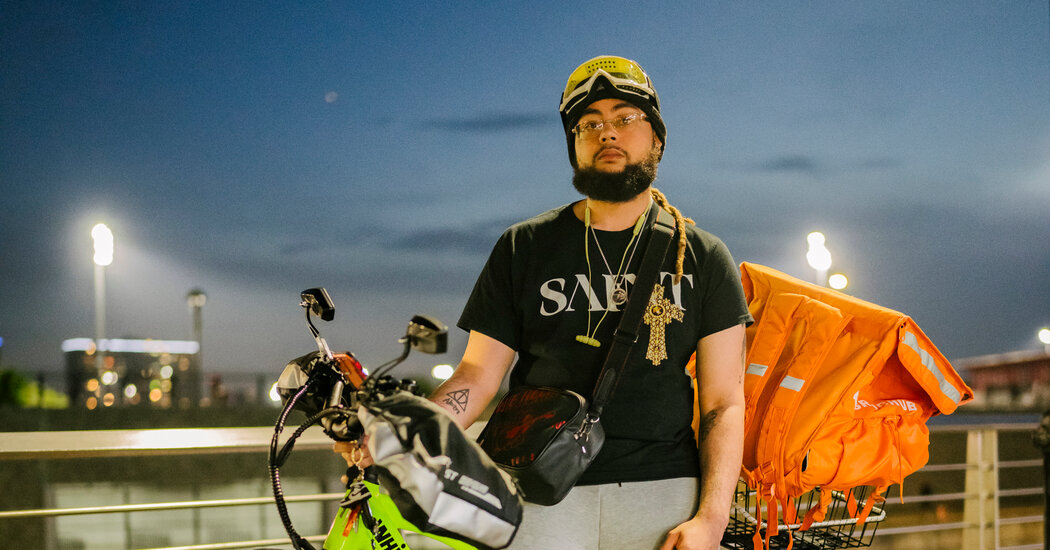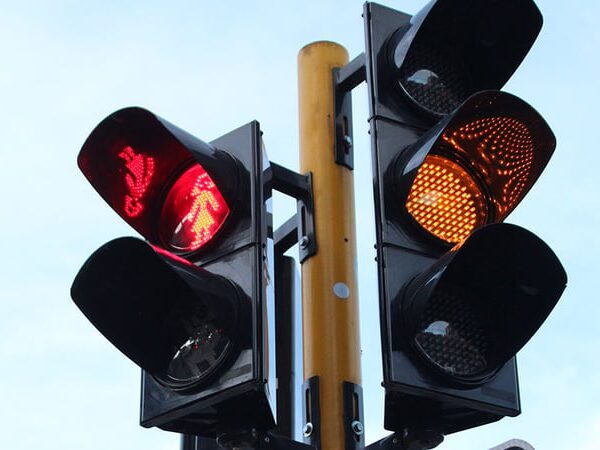Elijah Orlandi knows what many New Yorkers think about delivery workers on e-bikes: They ride too fast. They zigzag in and out of traffic and bike lanes — sometimes going the wrong direction altogether. They materialize on sidewalks, idle in groups and block the paths of pedestrians. They risk colliding with people, pets and cars in their rush to get where they’re going.
“There are scenarios where people have the right to be upset,” said Orlandi, who lives in the Bronx and has been making e-bike deliveries for Grubhub — in addition to his 9-to-5 job — since October. He has seen e-bike riders “swerving in between cars and all that kind of stuff.”
But Orlandi is also hoping for compassion. “People got to understand, we’re working,” he said. Delivery apps, he noted, keep track of how quickly workers make their drop-offs — and ding them if they take too long.
“Sometimes you’ll be going somewhere and Grubhub will send you another order, and then no matter what you do, you’re going to be late,” he said. “So that’s why you’ll see a lot of people rushing.”
Of all the new kinds of vehicles and obstacles on New York City’s busy streets and sidewalks, electric bicycles, which proliferated during the coronavirus pandemic, draw perhaps the sharpest opinions.
Delivery riders were considered “essential workers” during the lockdown, and the speed and ease of e-bikes made them attractive to deliveristas whisking food through the rain. The lockdown eventually lifted, but the popularity of home delivery — and electric bikes — remained.
Commuters, too, have turned to e-bikes. There have already been seven million rides on electric Citi Bikes this year.
But the explosion of e-bikes has also soured the way some New Yorkers view the streets.
“In the last three years there’s been an enormous shift,” said Susan Simon, who moved to New York in the late 1970s. “The quality of life has gone down.”
“The streets are very dangerous,” Simon continued. “What used to be a wonderful walking city for tourists, for pedestrians, has become something of a nightmare.”
Simon used to pedal a bike herself, for fun or to go to the grocery store. But e-bikes are different, she said — faster and heavier and therefore riskier. She noted that a woman was killed last year after someone riding an electric Citi Bike hit her.
There are some efforts to tame the chaos. Janet Schroeder and Pamela Manasse, who was hit by an electric vehicle in 2022 and suffered a severe brain injury, founded the NYC E-Vehicle Safety Alliance, which promotes various regulations for e-bikes.
The alliance supports a bill that would ban e-bikes and other e-vehicles from parks and greenways. It would also like the government to require that e-bikes be registered and riders licensed.
Schroeder said her organization includes 74 people who have been injured by e-bikes. In nearly all cases, she said, the rider fled immediately.
“It’s a free-for-all with no consequences whatsoever for the people on these bikes and mopeds,” Schroeder said.
Meera Joshi, New York’s deputy mayor for operations, acknowledges the difficulty in striking the right balance on city streets.
“We want to be accommodating to the convenience of technology and modern life,” she said, “but there’s no question we need to cut down on the Frogger feeling on our streets.”
Joshi described the city’s bike lanes as offices — crowded offices — for more than 70,000 delivery workers. She wants the city to gather data from delivery companies to help inform infrastructure improvements like widening those lanes. New York, she said, needs to “gain a deeper understanding of who is profiting from our roads, so we can rewire the incentives towards slowing down.”
E-bike riders themselves are especially vulnerable to danger. Zoey Laskaris and Mustafa Hussein, researchers at CUNY, recently published a study that found that food delivery gig workers in New York City face a high risk of injury and assault.
The situation is compounded by the fact that delivery app companies do not generally provide safety training, equipment, maintenance or workers’ compensation, the researchers said.
Laskaris suggested that New Yorkers also think about their own behavior. “We’ve all created this scenario,” she said, “where there’s ‘on demand, I want things delivered.’” The Upper West Side, where Manasse was injured, is one of the neighborhoods where people love getting food deliveries. By some counts it’s around 14,000 orders a day.
Joe Riggs, an e-bike rider who lives in Ridgewood, Queens, is more concerned about reckless motorists than e-bike riders: “You can’t count on vehicles to obey red lights,” he said. “It’s pretty terrifying.”
Riggs has 20 years of experience riding in the city and is “multimodal,” as he puts it. He has a minivan, but he usually commutes by e-bike or electric unicycle, and drops his kids off at school using an electric cargo bike.
He understands that e-bikes have a terrible reputation. “There’s lots of irresponsible e-bike riders, for sure,” he said. But, he added, “I can get to and from more quickly and have less difficulty parking and a lot more fun on the bicycle.”
For family outings, he prefers the electric cargo bike to the minivan. “They’re really viable car replacements for most families who live in a city and don’t need to travel outside of it,” he said. As for his children? “They love it.”
Quote of the week
What would your version of a utopian New York City look like?
A place where I can go for a bike ride with my mom. Is that too much to ask? — Henry Grabar, author of “Paved Paradise.”
Mailbag!
From the streetwars@nytimes inbox:
While I drive into N.Y.C. regularly and struggle to find parking when I do, the idea of increasing the amount of greenery on the streets appeals to me.
I was particularly taken by the idea of converting curbside spaces to micro-parks. Virtually every block has at least one fire hydrant. If I recall correctly, parking is supposed to be 15 feet on either side of the hydrant. Why not take that 30-foot span and tear out the asphalt, and install permeable green space. There could be room for a tree at either end and still leave plenty of room for the fire department to access the hydrant.
— Daniel Friedmann, Poughkeepsie, N.Y.















